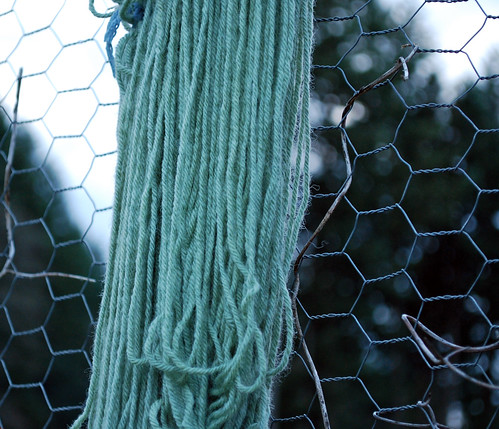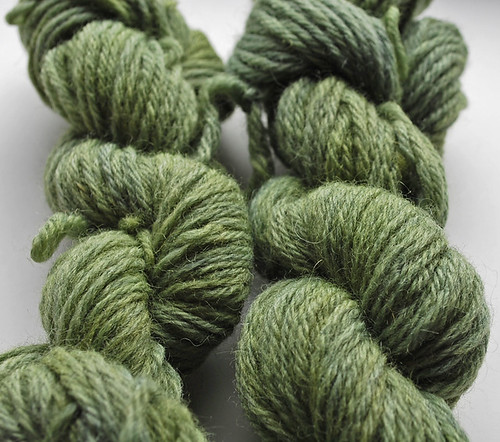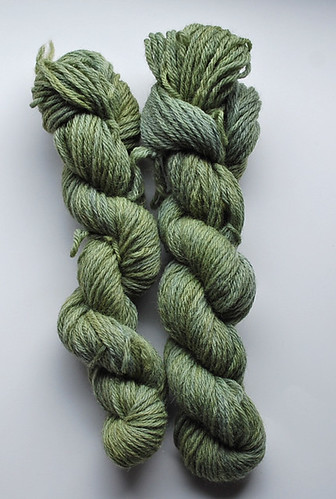Here is the picture from that post in case you don’t feel like clicking back to it.
It turned out to be a really pretty shade of green- sort of sage like but certainly not blue.
Last week I decide to attempt the black bean dye again and once again ended up with some interesting results. Still no blue but I was wowed by the shade of green I achieved. Normally I overdye an indigo dyed hank of yarn with a yellow natural dye (like goldenrod) to achieve such a green. I believe my recent results all lie in the type of well water we have at my home. Rather acidic really and not always easy to play with when it comes to my natural dyes.
Below is a picture of the two 2 ounce skeins that I dyed last week.
Can you note the variegations in the color in places? I love that part the most. I dyed these two skeins of yarn a little bit differently than my first initial attempt with the black bean dye.
For those interested, here is what I did this time around:
- Soaked about 3 cups of black beans for 12 hours with 1 Tablespoon of baking soda added to the water (to help the beans to soften up- I later turned them into dinner for us!)
- Drained the beans, reserving the now colored water. To this water I added my 2 skeins of yarn that had previously had alum applied to them as a mordant.
- Added more water to the beans plus another tablespoon of baking soda and allowed them to soak for another 12 hours.
- Once more I drained the beans and added this water to the dyepot with the already soaking skeins.
- For the final time I added fresh water once again to the beans along with another tablespoon of baking soda. I allowed them to soak for about another 12 hours.
- Finally, I drained the beans and again added this water to the dye pot. I then let the yarn soak about another 12 hours for a total of 48 hours.
So, the beans soaked for a total of 36 hours and the yarn for 48. After soaking I rinsed the yarns really well. (The last 12 hours of soaking didn’t make them smell so nice!) I then allowed them to air out outside. (I would have allowed them to dry out there but they ended up getting rained on- it was such a rainy month!)
The final results:
Here they are next to some yarn that I recently dyed using spent tea leaves.
I am going to knit these into a pair of pants for Baby Gabriel.
I hope I made this clear enough to follow. Please ask questions if I did not. I’m sure everyone else’s results will dramatically vary from mine. One of the exciting elements to natural dyes, I think! I love the fact that such a wonderful color can be achieved so simply from a product that is very easy to obtain. I hope this inspires some of you to give it a go!
















{ 10 comments… read them below or add one }
Hi Cynthia, welcome back to the blogging world! Missed you! I love the variations of green you achieved on that yarn. So cool.
Beautiful shade of green!
@Racquel & @Peg- Thanks! I’m working on the pair of pants right now and am loving how they are turning out with this yarn. Update photos will be sure to follow!
That was fun! I’m a knitter, and every resource for unique yarn is a treasure to me. Black bean green goes into the notebook. Thanks!
Beautiful result! Can you explain “previously had alum applied to them as a mordant.”?
Thank you Victoria! I’ll try to explain and hopefully put it to were everyone understands what I am trying to say.
A few weeks back I applied alum to the 2 skeins of yarn I used I to get them ready for dyeing. A mordant is applied to fibers to help the dye adhere better. Mordant literally means “to bite”. There are several mordants one can use in dyeing but alum is what I prefer. I like to apply mordant to several skeins of yarn at a time so I have them ready to be dyed with my natural dyes when the desire strikes me.
Hope that helps!
Thanks Cynthia!
Cool! I have seen a purple from black beans, but not a green. I might have to play with this. Is it light and wash fast?
Hi Maia and thanks for the comment! So far it has been pretty good at being light and wash fast. In fact I used the yarn in this photo to knit up some wool longies for my son and they have been used and abused and the color is still true and as strong as the day I dyed it. Have fun playing around with it!
Great! I will definitely put it on the list of things to try.
{ 1 trackback }